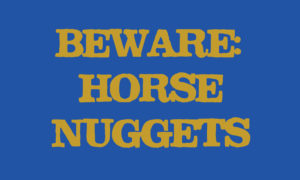Don’t confuse ‘Mass Awareness” with “Message Neutrality”.
Much has been made of the great work being done by Ehrenberg Bass in South Australia.
So much so, many marketers are choosing not to segment their markets at all.
A recent conversation with a prospective client highlighted what appears to be a growing mind-set in many Australian marketers.
When asked about market segmentation, and messaging to different customer types, the response was, “We don’t need to target women, we’re ‘Ehrenberg Bass’.”
I think they’re talking horse nuggets.
But I don’t blame Ehrenberg Bass.
To be fair to the team at the institute, they make their case very well.
The thought is simple. Mass awareness is more effective than segmented messaging.
The insight is a cannon over the bows of traditional marketing promises. Customers aren’t loyal to brands. (“72% of people who buy Coke also buy Pepsi.”)
There are a number of Commandments for their growing horde of disciples. Ten, as it turns out. The humility of the institute might suggest these are more golden threads than golden rules. But I’m just guessing.
1: The new metrics are not about differentiation.
2: Most customers don’t see brands as having a difference, or that the difference actually matters.
3: The real battle is about salience – being relevant to the customer in some way – and memorability – ensuring the customer remembers your brand at the point of purchase.
4: The real need is to build memory structures.
5: Make the brand easy to like, easy to memorise and easy to recall.
6: Make it easy for the customer to buy you again and again and again.
7: Marketing is, according to the institute, a constant battle for attention. Not love.
8: The key goal is mental and physical availability.
9: If your share of voice is above the market mean, and your offer is competitive, you’re more likely to grow your business.
10: If your share of voice is below the market mean, you’ll struggle.
There you go, marketing manager.
All your thinking has been done.
Go mass. Then go shopping.
However. There is a small fault in this logic.
Not with the findings of The Ehrenberg Bass Institute.
But in the implementation.
To grow brand share, the marketer must spend above the market mean.
If everyone is spending more, the market media spend will increase.
Which means, unless the marketer is spending increasingly more on mass awareness every year, they will be going backwards.
The thinking, to me anyway, is triggering a media arms race.
An increase in media spend, with brands either clearly spelling out the logical superiority of their offer or hitch-hiking on the societal trend of creating a brand with a purpose (“getting Sinek-y”).
And, while this is great news for media companies, and people who like putting pretty pictures next to a manifesto, it dumbs down advertising.
It stops us thinking about how we should connect and essentially says, “Make the logo bigger” – only in a scientific way.
Marketers need to look beyond the science of media and peer into the abyss of people’s emotions.
If you want to use the power of mass awareness, you can’t bland people into submission.
To borrow from Euripides, how can Ehrenberg Bass help you if you don’t help yourself?
Don’t just make the logo bigger. Make the brand take a bigger place in people’s hearts.
But more on that tomorrow.
Thanks for reading.


Leave A Comment